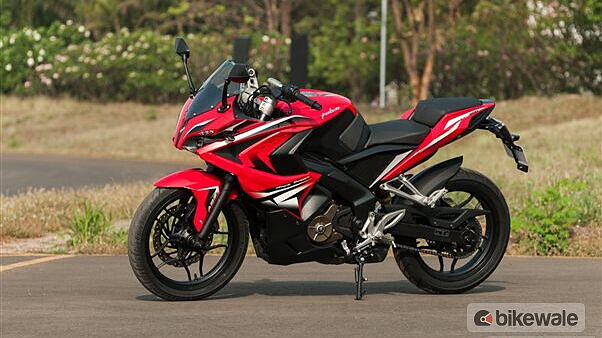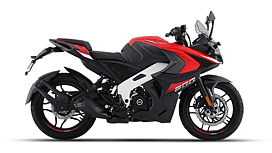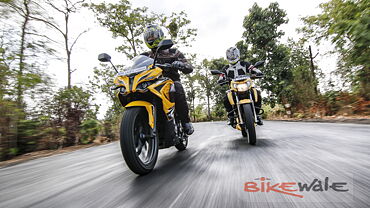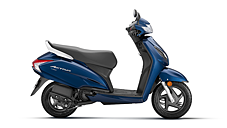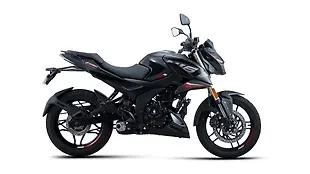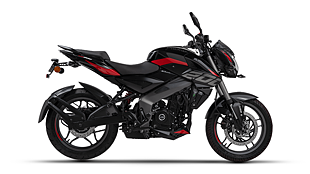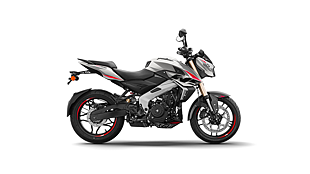Introduction

I was excited when I got an email from Bajaj Motorcycles to test their new motorcycle, the Pulsar RS200, at their Chakan test track. And there were two reasons - the Pulsar RS200 and the Chakan track. Over the last couple of months, we have written quite a few articles on the Pulsar RS200 ranging from it being spied around Pune to its name changing from SS200 to RS200. Honestly, I don’t think we have written so many spy pictures story for any another bike like we have done for the Pulsar RS200. It was the most anticipated motorcycle from Bajaj because it was going to open the doors of the budget fully-faired entry-level performance motorcycles. With India’s ever growing young population, the Pulsar RS200 seems to have attracted lot of interest. We take the Pulsar RS200 for a spin at Bajaj’s test track to find out how far it will take the legacy of the Pulsar brand.
Looks & Styling

Let us agree that the Pulsar RS200 is the prettiest motorcycle with the Bajaj badge. The overall design language is fresh and aggressive. Some design inspiration is visible from the Japanese but the Indian industrial designers have done a good job. But while I appreciate their effort, I find the motorcycle’s design a bit too busy. The front fascia reminds me of the Bumblebee from the famous Transformers property. Look very closely and the placements of the two projector headlamps will remind you of the rattlesnake – very aggressive, and with a character of its own. It gets two LED pilot lamps, which are flanked by small decals to make the design lively. The turn indicators are the ones seen on the KTM Duke 200. The windscreen is big and quite useful during rides.

The side profile of the Pulsar RS200 looks quite menacing. The multi-panel fairing has lot of sharp and deep creases and its romance with the decals make it look overdone. It doesn’t look bad, it is just that they could have slightly mellowed it down. But this won’t bother the target audience because the RS200 is coming from Bajaj; especially after looking at the overall performance package and value it has to offer. The cowl near the engine area doesn’t cover the engine and does more of an aerodynamic job. The perimeter frame is visible, but flows around really well with the rest of the bike. The fuel tank is not bulky and at the same time neither is it very sharp but Bajaj has integrated them well, leaving no gap between them. The finish given to the tank is not a glossy one but it is more of a rough fake carbon fibre finish. The most interesting aspect of this new tank is the introduction of a horizontally placed cushioned tank pad, which I quite like.

With this new bike, Bajaj has taken a new design approach and that is evident with the tail section where they have integrated grab bars onto the tail component. But I am sure the Kawasaki Ninja 300 played a big inspiration for them. The tail-light cluster design is something we are seeing for the first time on a production motorcycle. It is quite quirky and hard to accept for a motorcycle. The Pulsar RS200 gets a short, well-designed exhaust that complements the bike’s design. Overall, the Pulsar RS200 is surely going to attract lot of attention on the roads. The design is well targeted and we won’t be surprised if the bike becomes the dream of every college kid.
Features

In order to keep the costs in check, the Bajaj Pulsar RS200 retains the same instrument cluster from its naked sibling. The center console features an analog tachometer and a digital fuel indicator. The left side console sports neutral and turn indicators, oil-level and a battery indicator whereas the right console gets a small basic display comprising of the speedometer, two trip meters, time and the side-stand indicator. What I like about this cluster that it gets a blue backlight and that makes the cluster look very fresh and updated. There is an rpm shifter indicator as well, which lights up every time you rev till 10,000rpm. There is an important addition to this bike – a single channel ABS and an indicator on the center console for the same. There are two buttons to adjust the time and trip meter and I think they are made out of stone and are very hard to operate.

The switchgears are the same ones that are used on the Pulsar NS200, they are good, useful for the job and last long. The rear-view mirrors have been mounted on the fairing and provide very good visibility. I honestly don’t remember the last time I appreciated any Bajaj motorcycle when it comes to rear-view mirrors. The set on the Pulsar 220F were horrible and the ones on the Pulsar NS200 are no different. I am glad Bajaj has fixed this problem.
Performance

The Pulsar RS200 gets the same 200cc single-cylinder liquid-cooled engine from the Pulsar NS200. It gets the same bore and stroke, however, this one is fuel-injected. This engine develops 24.2bhp at 9,750rpm – 1bhp more than the Pulsar NS200. The torque has marginally gone up to 18.6Nm at 8,000rpm. Because of the fuel-injection, the engine is much smoother and the throttle response is crisper. Unlike the other Pulsars, this engine isn’t very harsh and feels very grown up with a good level of refinement. The overall power delivery is very predictable and linear. However, there is no bottom-end power. I stalled the bike a couple of times in the first gear. It gives you a feeling as if you are trying to move the RS200 in the second gear. After 4,000rpm, the Pulsar RS200 is so much fun to ride. This single-cylinder engine is mated to a six-speed gearbox that provides precise shifts. Gearing is different from the Pulsar NS200 with the final drive being a short one to compensate on the additional weight gain. The clutch is light and well-weighted.

Bajaj claims a top speed of 151kmph for the Pulsar RS200 and I managed to touch the 144kmph mark on the straight stretch at Bajaj’s test track. Because of the additional fairing and the ABS unit, the total weight of the bike has gone up by 20kg, which is a huge number. Even after weighing so much, the RS200 performed really well on the track. I was given only 30 minutes to test the bike, due to which the fuel efficiency numbers are not available. But with a fuel tank capacity of 13 litres, the Pulsar RS200 should manage to do 300 kilometres in one full tank. The overall performance of the Pulsar RS200 is well balanced. The company is not marketing it as a track bike but more of a road bike and it will manage to satisfy the riders in this department.
Ride & Handling

The Pulsar RS200 is not really a super sport motorcycle but has been developed to give a rider that feeling. With its tall clip-on handlebar, the riding position is quite comfortable and the foot pegs have moved closer to the rear. This has been done for a rider who wants to tour as well as race down a track.

The bike is very agile and dynamic on a track and it feels that it is ready for any kind direction changes you make. This was possible because of shorter wheelbase and longer swingarm as compared to the Pulsar NS200. The handling character of the RS200 is very precise, thanks to that excellent perimeter frame. There is a very good feedback from the front end. What impressed me the most are the MRF Zapper tyres, which provides mind-blowing grip, performance and gives you lot of confidence to attack corners. I rode the Pulsar RS200 on a track and that’s why I can’t really comment on the ride quality. It shares quite a lot of components with its naked siblings, making us believe that it definitely won’t be too bad.

The Pulsar RS200 is the first motorcycle in its family to get an ABS. It gets a single-channel Bosch unit on the bigger 300mm front disc, which means that it works only on the front wheel. Under panic braking, the front wheel won’t lock, however, the rear does lock up under hard braking. The overall bite is really good and confidence inspiring.
Verdict

Over the last few years, Pulsars have evolved but the RS200 has taken the game to a whole new level. With the Pulsar RS200, Bajaj tries to please a set of consumers, who have a soft corner for full fairing and performance. The RS200 is the best looking and the best equipped Pulsar till date. The overall new design language is a welcome move by the company and some bits of it will be carried forward to other motorcycles for sure. The performance is really appreciable and the introduction of single-channel ABS is a big value addition.
With a price tag of Rs 1.18 lakh (ex-showroom Pune) and Rs 1.30 lakh for the ABS version, the Pulsar RS200 is the most expensive bike from Bajaj’s line-up, but is also the most fun and attractive one. If you have a budget of sub-Rs 1.5 lakh and don’t want the KTM RC200 for its aggressive riding stance or for any other reason for that matter, the Bajaj Pulsar RS200 offers right balance in terms of performance and usability.
Gallery
1/38
Double Tap to Zoom











